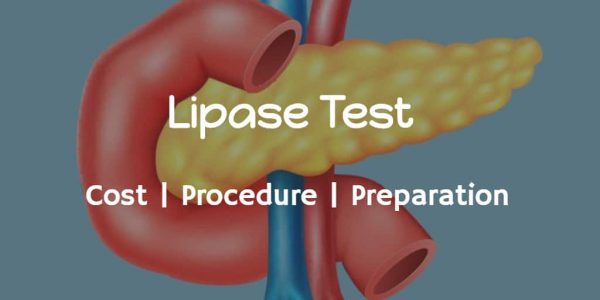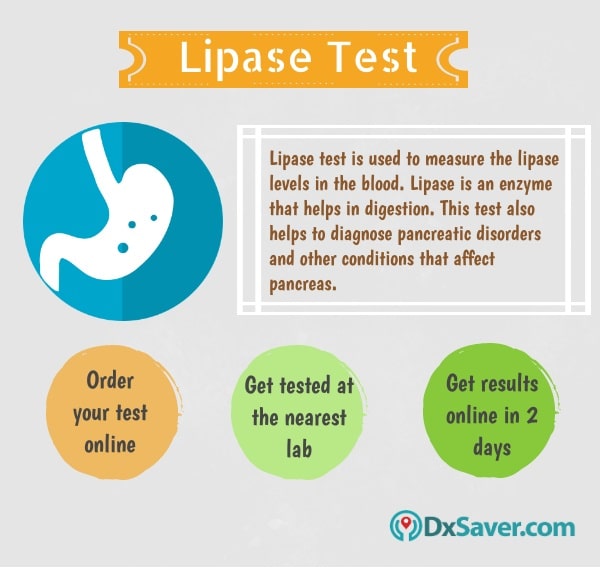
The lipase test is a simple blood test ordered by your physician to measure the level of lipase in your blood. Lipase is an enzyme that helps the intestines to break down fats. Certain levels of lipase are required to maintain digestive function. High and low levels of lipase can lead to serious health problems. So, we highly recommend everyone to get tested for lipase levels if you experience any unusual symptoms that are caused by elevated or low lipase levels.
The article below covers all the significant topics that are relevant to the lipase blood test. We cover lipase test cost, what is a lipase test, normal lipase test range, symptoms, lipase test procedure, preparation, risks, and how to get tested for a lipase blood test.
- Lipase test cost.
- What is lipase?
- What is a lipase test?
- When is a lipase test done?
- Lipase test normal range.
- How is the lipase test done?
- Is there any preparation required before the test?
- Are there any risks in the test?
- What does the lipase test result mean?
- How to treat high and low lipase ranges?
- Provider Locations
For our readers, who are very much interested in knowing the lipase test cost beforehand, we would like to begin with that section.
How much does a lipase test cost?
Lipase test cost ranges between $39 and $55 in different labs and facilities across the U.S. No prior appointment is required. Compare the price, order your test online and visit the nearest lab during lab business hours. Complete the procedure and get the results in your email in 2 to 3 business days. Doctor consultation is also available for further treatment or any kind of medical advice.
The following table shows the cost of a lipase test at 2 of our partner laboratories (CLIA – Certified) network located across the U.S.
Name of our Partner Labs | Book Online |
HealthLabs
| Offer Price$39 |
Personal Testing Lab
| Offer Price$55 |
Lipase test cost with insurance
Most of the health insurance policies in the U.S. cover the cost of the lipase test. However, the coverage offered by private health insurance companies and national health insurance programs like Medicare and Medicaid varies widely. So we recommend you to check the coverage of your health insurance plan with the insurance company before getting tested for lipase levels.
Our lipase testing providers do not accept any kind of health insurance plan. But, on request, they can provide you with an itemized receipt containing all the details like the name and code of the test, and CPT code that is necessary for insurance reimbursement purposes.

What is lipase?
Lipase is an enzyme that is produced by the pancreas during digestion. The pancreas is a large gland located behind the stomach and it secretes digestive enzymes in the pancreatic duct. Lipase enzyme is released into the digestive tract and helps the intestines to break down the fats in the food that you are eating. It is vital to maintain normal lipase levels for the proper functioning of the pancreas and digestive system.
What is a lipase test?
The lipase test is done to measure the levels of lipase in the blood. This test helps to diagnose pancreatic disorders such as a blockage in the pancreas, pancreatic cyst, and pancreatic inflammation (pancreatitis).
When is a lipase test done?
Your physician will order a lipase blood test if you experience the following symptoms that are caused by pancreatic disorders or if you are at a higher risk of getting pancreatic diseases.
Symptoms of pancreatic disorders
- Severe pain in the abdomen
- Severe back pain
- Nausea
- Vomiting
- Jaundice (yellowing of the skin and eyes)
- Diarrhea
- Foul-smelling stools
- Loss of appetite
- Fever
- Rapid pulse
- Weight loss
Risk factors of pancreatic disorders
- A family history of pancreatitis
- Diabetes
- Gall stones
- Obesity
- High triglycerides (a type of fat)
- Smoking
- Excess consumption of alcohol
The lipase test is also done to monitor the effectiveness of ongoing treatment for any pancreatic disorder. Sometimes, this test is also ordered to monitor other conditions such as
- Crohn’s disease (inflammation of the digestive tract)
- Celiac disease
- Peritonitis (inflammation of the lining of the inner abdominal wall)
- Infarcted bowel (bowel that has restricted the blood supply)
- Cystic fibrosis (a hereditary disorder that produces thick mucus resulting in the damage of organs)

Lipase test normal range
Generally, the normal levels of lipase enzyme are required to maintain regular digestive and cell function. The normal lipase range vary based on age, gender, health history, and method of testing. According to Mayo Medical Laboratories, In the adults above 16, normal range of lipase levels between 10 to 73 U/L (units per liter of blood).
How is the lipase test done?
The lipase test is a simple test done with a sample of blood.
During this test, a lab technician or a phlebotomist will cleanse the area to be injected with an antiseptic liquid and wrap an elastic band around the upper arm to make the vein visible and pool with blood. He/she then injects a needle to draw a sample of blood. After the blood is drawn, he/she will ask you to apply pressure on the insertion site with a band-aid or a cotton ball to stop bleeding. The blood sample that is collected in a test tube is sent to the lab for further testing.
It takes less than 5 to 10 minutes to perform this test.
Is there any preparation required before the test?
There is no special preparation required for the lipase blood test. There is no constraint on the diet. But, your physician may ask you to stop certain medications that include birth control pills, codeine, morphine, and thiazide diuretics and herbal supplements. Because these medications and supplements can affect the results of the test.
If you have any abnormal bleeding disorder, inform your physician before the test.
Are there any risks in the test?
There are no possible risks or complications in the lipase blood test. Sometimes, after the blood sample is drawn, you might feel dizziness, slight pain, bruise, or redness in the injected area for a very little period.
What does the lipase test result mean?
The high and low lipase levels indicate different medical conditions.
If your lipase test results show lower levels of lipase than normal, it indicates that there is permanent damage to the pancreatic cells that produce lipase. This can be caused by chronic pancreatitis (inflammation of the pancreas that doesn’t heal or improve) or cystic fibrosis.
If you have elevated lipase levels which is unusually higher than normal, it indicates several conditions such as
- Acute pancreatitis (sudden inflammation of the pancreas)
- Pancreatic cancer
- Celiac disease
- Gall stones
- Viral gastroenteritis (stomach flu that causes inflammation of the stomach and the intestines)
- Bowel obstruction
- Cholecystitis (sudden inflammation of the gall bladder)
- Cirrhosis (scarring of liver tissue)
- Kidney failure
If appropriate and necessary, your physician will also order an amylase blood test which is another important digestive enzyme and other imaging tests such as MRI and CT to look at the pancreas.
How to treat elevated lipase test levels?
In most cases, the lipase test results show elevated lipase levels which are associated with acute pancreatitis. If this condition is found at an early stage, intravenous fluids and certain medications will be prescribed by your physician to treat the condition. As a result, the lipase levels will be lowered. If other conditions are responsible for the elevated lipase level, then receiving treatment should bring the lipase level back to normal.
How to treat low lipase test levels?
If your lipase test results indicate low lipase range, medications, and some therapies might be prescribed to treat the conditions that cause low lipase levels.
Provider Locations
A lipase blood test can be done at any of our partner’s 4500+ labs located across the US. To know the lipase test cost, refer to the first section of the article.
Frequently Asked Questions
What is a lipase blood test?
A lipase blood test measures the level of the enzyme lipase in the blood. Lipase is produced by the pancreas and helps break down fats in the small intestine.
Why is a lipase blood test done?
A lipase blood test is done to help diagnose and monitor pancreatitis, which is inflammation of the pancreas. It can also be used to evaluate the cause of abdominal pain.
How is a lipase blood test done?
A lipase blood test is done by drawing blood from a vein in your arm. The blood is then sent to a laboratory for analysis.
What do high levels of lipase in the blood mean?
High levels of lipase in the blood can be a sign of pancreatitis, but can also be caused by other conditions such as a blocked duct in the pancreas or a kidney or liver problem.
What do low levels of lipase in the blood mean?
Low levels of lipase in the blood can be a sign of a problem with the pancreas such as chronic pancreatitis, cystic fibrosis, or cancer.
Other topics you may be interested in:-
- Sickle Cell Test Cost in the U.S.
- Eye Chlamydia Symptoms
- What STDs cause Sore Throat?
- Cost of Estrogen Test Cost in the U.S.
- How much does CEA Testing Cost in the U.S?
- At-Home Chlamydia Testing Cost in the U.S.
- Testosterone Test Cost in the U.S.
- Cost of Stool Culture Test Cost in the U.S
- C-Peptide Test Cost in the U.S.
- Fitness Testing Cost in the U.S.
- STD Testing Cost in the US
- How much does IGF-1 Testing Cost in the U.S?
- Renal Panel (Kidney Function Panel) Test Cost in the U.S.
- Causes of Penile Rashes and Other STD Symptoms in Men
- HPV in Women: Symptoms, Genital Warts, Treatment and More
- Importance of Ferritin Hormone, Normal Levels, Diagnosis & Treatment
- Is Bacterial Vaginosis an STD? Know more about its Causes, Symptoms & Treatment
- What is D-Dimer Test? Know more on Normal Levels, Diagnosis & Treatment






